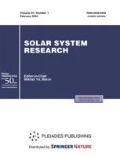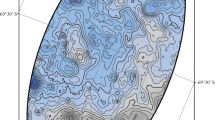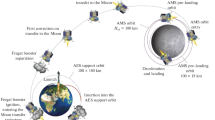Abstract
At present, the task of selecting landing sites for the Luna 27 spacecraft is provided with alarge amount of actual data, often with a higher spatial resolution compared to the data used to select of the Luna 25 landing sites. In addition, more data about the lunar surface with a spatial resolution comparable to the size of a spacecraft can be further obtained using the Luna 26 orbiter. Preliminary estimates of the lunar surface conditions in the south polar region, south of 80° S, for the landing of Luna 27 spacecraft have revealed the need to seriously improve the landing accuracy in comparison with the Luna 25 landing ellipse. The size of such landing ellipse south of 80° S makes a safe landing almost impossible since the surface near the Moon’s south pole does not have a single smooth and illuminated area of that size. Increasing the landing accuracy up to 5 km opens up the possibility of choosing a landing site among six candidates. A further increase in landing accuracy up to 3 km can provide a wide choice among 15 candidate sites, each allowing both a safe landing and the accomplishment of the Luna 27 scientific mission. Finally, with a landing accuracy of about 500 m, one can outline vast areas in the vicinity of the south pole with numerous sites offering favorable conditions both for a safe landing and for carrying out an extensive scientific program.







Similar content being viewed by others
REFERENCES
Bussey, D.B.J., McGovern, J.A., Spudis, P.D., Neish, C.D., Noda, H., Ishihara, Y., and Sorensen, S.-A., Illumination conditions of the south pole of the Moon derived using Kaguya topography, Icarus, 2010, vol. 208, no. 2, pp. 558–564.
Djachkova, M.V., Litvak, M.L., Mitrofanov, I.G., and Sanin, A.B., Selection of Luna-25 landing sites in the South Polar Region of the Moon, Sol. Syst. Res., 2017, vol. 51, no. 3, pp. 185–195.
Dolgopolov, V.P., Efanov, V.V., Zaitseva, O.N., Zelenyi, L.M., Martynov, M.B., and Pichkhadze, K.M., Future spacecraft for fundamental and applied research of the Moon, Kosmonavtika Raketostr., 2011, no. 3 (64), pp. 52–65.
Garrick-Bethell, I. and Zuber, M.T., Elliptical structure of the lunar South Pole–Aitken basin, Icarus, 2009, vol. 204, no. 3, pp. 399–408.
Ivanov, M.A., Hiesinger, H., van der Bogert, C.H., Orgel, C., Pasckert, J.H., and Head, J.W., Geologic history of the northern portion of the South Pole–Aitken basin on the Moon, J. Geophys. Res.: Planets, 2018, vol. 123, no. 10, pp. 2585–2612.
James, P.B., Smith, D.E., Byrne, P.K., Kendall, J.D., Melosh, H.J., and Zuber, M.T., Deep structure of the lunar South Pole–Aitken basin, Geophys. Res. Lett., 2019, vol. 46, no. 10, pp. 5100–5106.
Mazarico, E., Neumann, G.A., Smith, D.E., Zuber, M.T., and Torrence, M.H., Illumination conditions of the lunar polar regions using LOLA topography, Icarus, 2011, vol. 211, pp. 1066–1081.
Melosh, H.J., Kendall, J., Horgan, B., Johnson, B.C., Bowling, T., Lucey, P.G., and Taylor, G.J., South Pole–Aitken basin ejecta reveal the Moon’s upper mantle, Geology, 2017, vol. 45, pp. 1063–1066.
Mitrofanov, I.G., Sanin, A.B., and Litvak, M.L., Water in the Moon’s polar regions: Mapping results from the LEND neutron telescope, Dokl. Ross. Akad. Nauk, 2016, vol. 466, no. 6, pp. 660–663.
Moriarty, D.P., Watkins, R.N., Valencia, S.N., Kendall, J.D., and Petro, N.E., Mineralogy of thorium-enhanced materials within the South Pole–Aitken basin: Possible traces of the lunar upper mantle, 50th Lunar and Planet. Sci. Conf., 18–22 March, 2019, Woodlands, TX, LPI Contribution no. 2132, id. 2874.
Paige, D.A., Foote, M.C., Greenhagen, B.T., Schofield, J.T., Calcutt, S., Vasavada, A.R., Preston, D.J., Taylor, F.W., Allen, C.C., Snook, K.J., Jakosky, B.M., Murray, B.C., Soderblom, L.A., Jau, B., Loring, S., Bulharowski, J., Bowles, N.E., Thomas, I.R., Sullivan, M.T., Avis, C., De Jong, E.M., Hartford, W., and McCleese, D.J., The Lunar Reconnaissance Orbiter Diviner Lunar Radiometer Experiment, Space Sci. Rev., 2010, vol. 150, nos. 1–4, pp. 125–160.
Sanin, A.B., Mitrofanov, I.G., Litvak, M.L., Bakhtin, B.N., Bodnarik, J.G., Boynton, W.V., Chin, G., Evans, L.G., Harshman, K., Fedosov, F., Golovin, D.V., Kozyrev, A.S., Livengood, T.A., Malakhov, A.V., McClanahan, T.P., Mokrousov, M.I., Starr, R.D., Sagdeev, R.Z., Tret’yakov V.I., and Vostrukhin, A.A., Hydrogen distribution in the lunar polar regions, Icarus, 2017, vol. 283, pp. 20–30.
Schultz, P.H. and Crawford, D., Origin of nearside structural and geochemical anomalies on the Moon, Recent Advances and Current Research Issues in Lunar Stratigraphy, Ambrose, W.A. and Williams, D.A., Eds., Geological Soc. Am. Special Papers, 2011, vol. 477, pp. 141–159.
Smith, D.E., Zuber, M.T., Jackson, G.B., Cavanaugh, J.F., Neumann, G.A., Riris, H., Sun, X., Zellar, R.S., Coltharp, C., Connelly, J., Katz, R.B., Kleyner, I., Liiva, P., Matuszeski, A., Mazarico, E.M., McGarry, J.F., Novo-Gradac, A.-M., Melanie, N.O., Peters, C., Ramos-Izquierdo, L.A., Ramsey, L., Rowlands, D.D., Schmidt, S., Scott, V.S., Shaw, G.B., Smith, J.C., Swinski, J.-P., Torrence, M.H., Unger, G., Yu, A.W., and Zagwodzki, T.W., The Lunar Orbiter Laser Altimeter Investigation on the Lunar Reconnaissance Orbiter Mission, Space Sci. Rev., 2010, vol. 150, pp. 209–241.
Tretyakov, V.I., Zelenyi, L.M., and Mitrofanov, I.G., Overview of Luna-27 science instruments, The Eleventh Moscow Int. Solar Syst. Symp., October 5–9, 2020, Moscow, Russia, id. 11MS3-MN-10.
Vondrak, R., Keller, J., Chin, G., and Garvin, J., Lunar Reconnaissance Orbiter (LRO): Observations for lunar exploration and science, Space Sci. Rev., 2010, vol. 150, pp. 7–22.
Funding
This work was supported by the Ministry of Science and Higher Education of the Russian Federation, project no. AAAA-A18-118012290370-6.
Author information
Authors and Affiliations
Corresponding author
Ethics declarations
The authors declare that they have no conflicts of interest.
Additional information
Translated by A. Kobkova
Rights and permissions
About this article
Cite this article
Djachkova, M.V., Mitrofanov, I.G., Sanin, A.B. et al. Selecting a Landing Site for the Luna 27 Spacecraft. Sol Syst Res 56, 145–154 (2022). https://doi.org/10.1134/S0038094622030029
Received:
Revised:
Accepted:
Published:
Issue Date:
DOI: https://doi.org/10.1134/S0038094622030029




